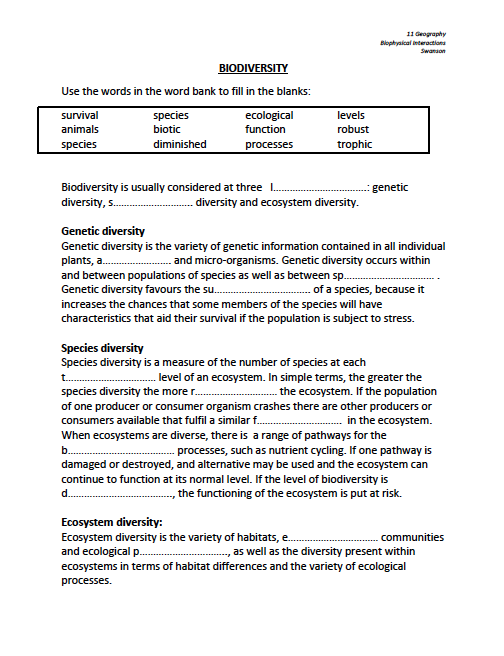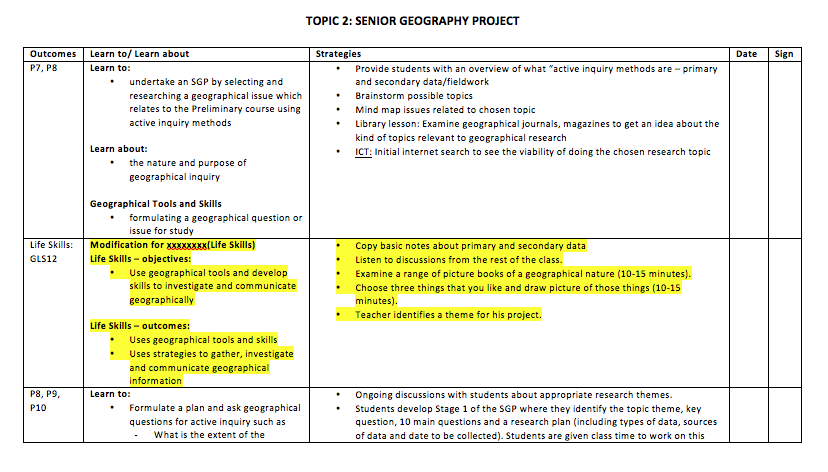|
Students who have experienced significant difficulty completing the 7-10 Geography may consider completing the Life Skills course. For information about how to determine whether a student is suitable for a Life Skills course, and the processes that need to be followed (e.g. consultation with parents, etc), see the HSIE Life Skills course on the NESA website. Preparing for a student completing the Life Skills Preliminary Geography course can be daunting. In many ways it will be like running two courses in the one classroom, but there are ways to make it a bit easier. Here are a few hints and tips... Running two courses at onceWhile Life Skills content and outcomes don't match the mainstream course, there are enough links between the two courses that they can run in parallel. Essentially you will running two courses at once in your classroom. You will run your mainstream course with the majority of your students, and then address the outcomes and content of the Life Skills course at the same time with the one (or couple of) Life Skills student/s. Have a look at the Life Skills course and see where the content and outcomes match the mainstream course. Even if it means rearranging the order, design the delivery of the Life Skills course so that as much as possible you are delivering similar concepts and content at the same time. For example cover the Life Skills content related to recognising physical elements of environments at the same time as mainstream students address content related to biophysical environments at the beginning of the Biophysical Interactions topic. Or cover the Life Skills content on patterns of human activity, when the mainstream class is covering Population. This will mean that all students are part of the same conversations and discussions, but can be given different individual work. It may work out that the Life Skills student can also be involved in some aspects of class group activities, depending on the complexity of the tasks. Seeking supportMake sure that you access any support that you can from the school. This might be the Learning and Support Teacher (LaST) or a Student Learning Support Officer (SLSO). Not everyone is comfortable having a support teacher in the classroom, and you need to work with the person and establish a bit of a routine to make it work well. You will need to get used to having another instructor that might talk when you're asking the students to be quiet, or that repeats instructions, but if this is what has to happen for the student to engage in the work, then you have to deal.Don't expect them to design the resources for the student. Support staff are unlikely to be Geography trained. They might be able to give you some lesson ideas to engage the student, but you will need to design the actual resources. Lesson modificationsModifying class activities might be as simple as giving a few extra clues. For example, you might include a cloze passage in a lesson to help build student literacy skills and provide a quick recap of information. A Life Skills student may require the following modification: - extra time to complete the task (mainstream students might take 5-10 minutes, but Life Skills students may need considerably longer). - some extra clues (e.g. providing the first letter of the answer) - larger text and simplified layout to make it less daunting - one-on-one assistance from the classroom teacher or SLSO. Below is an example of a cloze passage that has been modified, including the downloadable files.
Fieldwork It is possible to lead a Life Skills student through the same fieldwork skills and tools as the rest of your class. If you do activities outside with your class practicing soil testing, water testing, field sketches, etc, the student can still participate in much of this, but may not be able to analyse the results in the same way as the mainstream students. These activities also provide a great way of providing some mentoring and leadership opportunities for your mainstream students. They could take turns in being paired with the Life Skills student to model fieldwork techniques or assist in conducting tests. This is also a nice way to help your students to bond and teaches them some responsibility and understanding. Senior Geography Project and FieldworkThe SGP will need to be scaffolded heavily. You might choose to provide the student with some picture books or geographically themed magazine to help them identify topics they are interested in. Depending on the student's capabilities, it may be the case that the teacher ends up identifying a topic for the student. Unless the Life Skill student's parents are very engaged, it is likely to be easier to develop the SGP project around the school playground so that they can be guided through different parts of the project at school. It might be worth providing the student with a separate exercise book that they keep all their SGP notes, fieldwork, articles, etc in. The teacher or SLSO might find a couple of relevant websites and print them for the student. The SLSO could spend some time in class underlining key points and concepts and helping the student to write a couple of sentences about the topic. The completed assignment for a Life Skills student would include the student's SGP exercise book, as well as a short description on the project. The teacher would need to make a judgement based on the student's abilities regarding the length and depth required. Below: Excerpt from SGP program. Downloadable file below.
Sourcing resourcesIt may be useful to look at resources for lower ages groups/stages. For example, if you are studying Biophysical Interactions you might choose to supplement your resources with activities from Stage 3 Water In the World and Landscapes and Landforms. You may also look at picture books and non-fiction books designed for late primary or early high school. Have a chat with your school librarian about the topics for Year 11 and ask them to find some suitable texts.
0 Comments
|
Categories
All
Archives
May 2024
|
||||||||||||||||||||


